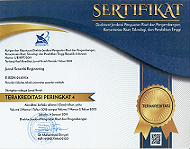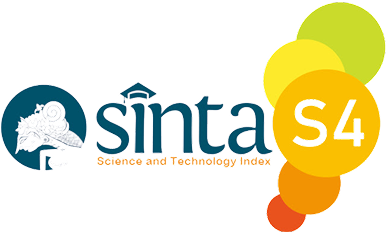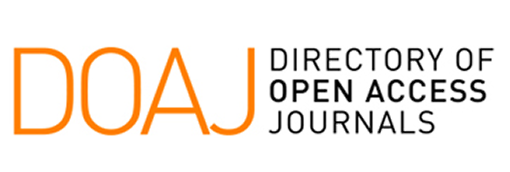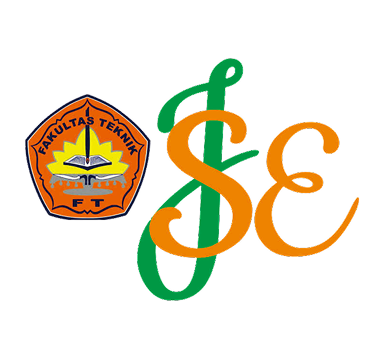Persebaran Logam Berat dalam Air Tanah di Sekitar Area Penimbunan Abu Batu Bara pada Lahan Bekas Tambang Kota Sawahlunto
Keywords:
coal ash, former coal mine land, heavy metal, landfillAbstract
Coal ash from the Sawahlunto City coal mine is used to backfill former mine land. This application poses a clear threat to groundwater quality. The objective of this study is clear: to analyze the concentration of heavy metals, including Ni and Cu, and their distribution in groundwater around the coal ash landfill area using response surface methodology in design of experiments. Groundwater samples were taken three times at four locations spaced 0 m, 365 m, 730 m, and 850 m by guiding SNI 6989.58.2008. Laboratory tests of metal concentrations refer to SNI 6989-84:2019. Water quality analysis showed Ni concentration exceeded drinking water quality standards with a measured concentration of 0.227 mg/L, while Cu parameters were still within safe limits with concentrations of 0.0002 mg/L and 0.02 mg/L. The metal distribution analysis definitively showed that coal ash landfilling in the former mining area contributed to groundwater pollution by Ni. The distribution pattern of Ni and Cu decreases with increasing distance. It is imperative that the FABA landfill area be located away from settlements that use groundwater to protect consumers. Further research is needed to determine the safe distance between the coal ash landfill site and groundwater sources.
References
[1] A. H. Ahmad, P. S. Darmanto, H. Hariana, A. Darmawan, M. Aziz, and F. B. Juangsa, “Numerical investigation of coal-sawdust co-firing in a Carolina-type boiler: Power derating and emission analysis,” Appl Therm Eng, vol. 266, p. 125681, 2025, doi: https://doi.org/10.1016/j.applthermaleng.2025.125681.
[2] A. Alhassan, I. Ozturk, M. F. AL-Zyoud, and F. V. Bekun, “Coal consumption-environmental sustainability nexus in developed and developing major coal-consuming economies,” Heliyon, vol. 10, no. 4, p. e25619, 2024, doi: https://doi.org/10.1016/j.heliyon.2024.e25619.
[3] I. D. Apriliyanti and D. B. Nugraha, “Burning coal in a cleaner way: Institutional fragmentation, power dynamics, and business influence in Indonesia’s biomass co-firing imaginaries,” Energy Res Soc Sci, vol. 121, p. 103949, 2025, doi: https://doi.org/10.1016/j.erss.2025.103949.
[4] T. Wijayanto, D. F. Hakam, and P. N. Kemala, “Vision for Indonesia’s 2050 power generation: Scenarios of hydrogen integration, nuclear energy prospects, and coal phase-out impact,” Sustainable Futures, vol. 9, p. 100438, 2025, doi: https://doi.org/10.1016/j.sftr.2025.100438.
[5] T. Prasetiawan, “Kontroversi penghapusan FABA dari daftar limbah B3,” Pusat Penelitian Badan Keahlian DPR RI, vol. Vol. XIII, pp. 1–6, Apr. 2021, Accessed: Sep. 06, 2023. [Online]. Available: http://berkas.dpr.go.id/puslit/files/info_singkat/Info%20Singkat-XIII-7-I-P3DI-April-2021-223.pdf
[6] M. A. Rais, D. T. Suryaningtyas, D. P. T. Baskoro, and F. Hazra, “Utilization of fly ash - Bottom ash, compost and arbuscular mycorrhizal fungi on growth of crops,” in IOP Conference Series: Earth and Environmental Science, 2021. doi: 10.1088/1755-1315/756/1/012065.
[7] A. S. Boche, S. J. Dhoble, S. S. Gupte, C. M. Dudhe, and R. M. Belekar, “Fly ash-induced groundwater contamination and magnetic nanoparticles as an innovative adsorbent for remediation: A critical review,” Hybrid Advances, vol. 10, 2025, doi: 10.1016/j.hybadv.2025.100461.
[8] A. Munyengabe, L. S. Kamogelo, T. Y.-A. Ngmenzuma, and M. F. Banda, “The Potential of Helichsryum splendidum (Thunb.) Less. for the Restoration of Sites Polluted with Coal Fly Ash,” Plants, vol. 13, no. 18, 2024, doi: 10.3390/plants13182551.
[9] X. Deng et al., “Evaluation of the migration and environmental effects of metal elements within cementitious gangue-fly ash backfill in underground coal mines,” Int J Min Sci Technol, vol. 34, no. 11, pp. 1551–1562, 2024, doi: https://doi.org/10.1016/j.ijmst.2024.11.002.
[10] S. Xu, Y. Zhang, J. Guo, A. Wu, X. Xiang, and H. Sun, “Experimental and modeled analysis of contaminant mobility in coal fly ash landfills under continuous rainfall regimes,” Sci Rep, vol. 15, no. 1, 2025, doi: 10.1038/s41598-025-86591-x.
[11] A. B. K. Majlis et al., “Intrinsic characteristics of coal combustion residues and their environmental impacts: A case study for Bangladesh,” Fuel, vol. 324, 2022, doi: 10.1016/j.fuel.2022.124711.
[12] Z. Zhang et al., “Ecological Risk Assessment and Influencing Factors of Heavy-Metal Leaching From Coal-Based Solid Waste Fly Ash,” Front Chem, vol. 10, 2022, doi: 10.3389/fchem.2022.932133.
[13] R. Eryanto, F. Herista, M. Teknik, S. Um, S. Barat, and D. P. Skripsi, “Analisis kebutuhan air bersih Kota Sawahlunto,” Ensiklopedia Research and Community Service Review, vol. 1, no. 1, 2021, [Online]. Available: http://jurnal.ensiklopediaku.org
[14] S. Sutomo, S. Sagala, B. Sutomo, S. Wrinarti, and G. Sanjaya, “Accelerating the provision of safe water supply in urban and rural areas of Indonesia,” Kesmas, vol. 16, no. 3, pp. 137–144, 2021, doi: 10.21109/kesmas.v16i3.5225.
[15] N. Shetty, J. K. Shetty, D. M. Chadaga, and D. U. Shankara H N, “Trace Analysis of Heavy Metals in Ground Water and Soil near Coal Based Thermal Power Plant Udupi Karnataka,” Journal of University of Shanghai for Science and Technology, vol. 23, no. 2, Feb. 2021, doi: 10.51201/jusst12608.
[16] O. Al-Hashimi et al., “A comprehensive review for groundwater contamination and remediation: Occurrence, migration and adsorption modelling,” Oct. 01, 2021, MDPI. doi: 10.3390/molecules26195913.
[17] C. Verma, S. Madan, and A. Hussain, “Heavy metal contamination of groundwater due to fly ash disposal of coal-fired thermal power plant, Parichha, Jhansi, India,” Cogent Eng, vol. 3, no. 1, 2016, doi: 10.1080/23311916.2016.1179243.
[18] L. Evans, P. Harrison, J. Lawrence, J. Casell, D. Thiemann, and J. Kim, “Coal Ash Primer,” 2023.
[19] T. Lekgoba, F. Ntuli, and T. Falayi, “Application of coal fly ash for treatment of wastewater containing a binary mixture of copper and nickel,” Journal of Water Process Engineering, vol. 40, Apr. 2021, doi: 10.1016/j.jwpe.2020.101822.
[20] A. Papandreou, C. J. Stournaras, and D. Panias, “Copper and cadmium adsorption on pellets made from fired coal fly ash,” J Hazard Mater, vol. 148, no. 3, pp. 538–547, Sep. 2007, doi: 10.1016/j.jhazmat.2007.03.020.
[21] A. Haggerty, E. Silva, T. Anderson, D. Bell, C. Mason, and K. S. Denholm, “Identifying critical control points for colostrum contamination in first milking colostrum from Scottish dairy herds,” Prev Vet Med, vol. 239, p. 106514, 2025, doi: https://doi.org/10.1016/j.prevetmed.2025.106514.
[22] S. Mukhopadhyay, R. Dutta, and P. Das, “Process optimization of microwave-assisted extraction (MAE) of polycyclic aromatic hydrocarbons (PAHs) from leaves of Murraya paniculata (L.) Jack: Process intensification approach,” Chemical Engineering and Processing - Process Intensification, vol. 212, p. 110284, 2025, doi: https://doi.org/10.1016/j.cep.2025.110284.
[23] Z. Khoshraftar, “Modeling of CO2 solubility and partial pressure in blended diisopropanolamine and 2-amino-2-methylpropanol solutions via response surface methodology and artificial neural network,” Sci Rep, vol. 15, no. 1, p. 1800, 2025, doi: 10.1038/s41598-025-86144-2.
[24] A. Fakhri, “Application of response surface methodology to optimize the process variables for fluoride ion removal using maghemite nanoparticles,” Journal of Saudi Chemical Society, vol. 18, no. 4, pp. 340–347, 2014, doi: 10.1016/j.jscs.2013.10.010.
[25] Y. Liu, Y. Zheng, and A. Wang, “Response Surface Methodology for Optimizing Adsorption Process Parameters for Methylene Blue Removal by a Hydrogel Composite,” 2010.
[26] S. K. Choi, S. Lee, Y. K. Song, and H. S. Moon, “Leaching characteristics of selected Korean fly ashes and its implications for the groundwater composition near the ash disposal mound,” 2002. [Online]. Available: www.cuk.ac.kr
[27] J. Wang, G. Liu, Y. Liu, C. Zhou, Y. Wu, and Q. Zhang, “Mobilization of substance around stackable fly ash and the environmental characteristics of groundwater: With particular reference to five elements: B, Ba, Pb, Sb and Zn,” Fuel, vol. 174, pp. 126–132, Jun. 2016, doi: 10.1016/j.fuel.2016.01.092.
[28] C. Verma, A. Hussain, S. Madan, and V. Kumar, “Assessment of heavy metal pollution in groundwater with respect to distance from ash pond by using heavy metal evaluation index,” Appl Water Sci, vol. 11, no. 3, Mar. 2021, doi: 10.1007/s13201-021-01390-9.
[29] A. Ram, S. K. Tiwari, H. K. Pandey, A. K. Chaurasia, S. Singh, and Y. V. Singh, “Groundwater quality assessment using water quality index (WQI) under GIS framework,” Appl Water Sci, vol. 11, no. 2, Feb. 2021, doi: 10.1007/s13201-021-01376-7.
[30] Chancal, S. Madan, and A. Hussain, “Groundwater contamination due to fly ash disposal: A Review,” Int J Adv, vol. I, no. 6, pp. 237–250, 2014.
[31] S. Bhattacharya, “Central Composite Design for Response Surface Methodology and Its Application in Pharmacy,” in Response Surface Methodology in Engineering Science, IntechOpen, 2021. doi: 10.5772/intechopen.95835.
[32] S. Madala, V. N. R. Mudumala, S. Vudagandla, and K. Abburi, “Modified leaf biomass for Pb(II) removal from aqueous solution: Application of response surface methodology,” Ecol Eng, vol. 83, pp. 218–226, Oct. 2015, doi: 10.1016/j.ecoleng.2015.06.025.
[33] N. Wang, X. Sun, Q. Zhao, Y. Yang, and P. Wang, “Leachability and adverse effects of coal fly ash: A review,” Sep. 05, 2020, Elsevier B.V. doi: 10.1016/j.jhazmat.2020.122725.
[34] M. Noskov, I. Solodov, A. Kesler, and T. Terovskaya, “Groundwater Contamination and Self-Purification At Uranium Production By The In-Situ Leaching Process,” 2018.
[35] K. M. Rizwan, V. Thirukumaran, and M. Suresh, “Assessment and source identification of heavy metal contamination of groundwater using geospatial technology in Gadilam River basin, Tamil Nadu, India,” Appl Water Sci, vol. 11, no. 6, Jun. 2021, doi: 10.1007/s13201-021-01436-y.
Downloads
Published
Issue
Section
License
Copyright (c) 2025 Dedi Harian, Shinta Indah, Ansiha Nur (Author)

This work is licensed under a Creative Commons Attribution 4.0 International License.












